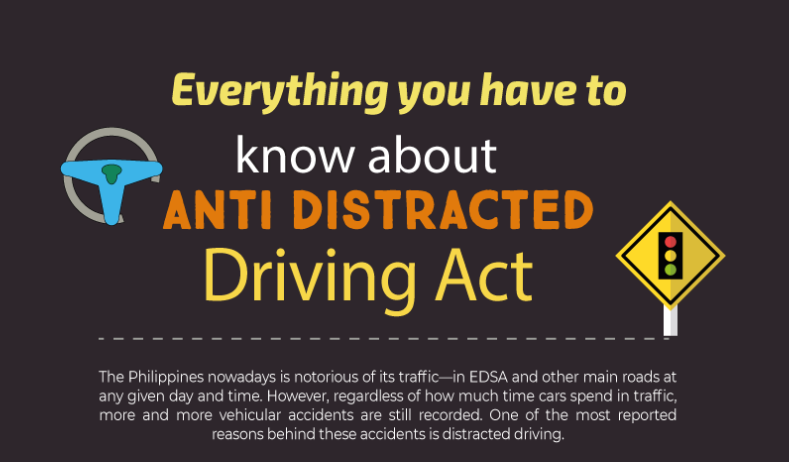Everything you have to know about the Anti-Distracted Driving Act [Infographic]
The Philippines nowadays is notorious for its traffic—in EDSA and other main roads at any given day and time. However, regardless of how much time cars spend in traffic, more and more vehicular accidents are still recorded. One of the most reported reasons behind these accidents is distracted driving.
In fact, according to the Philippine Statistics Authority (PSA), drivers who use their cellphones and other gadgets while behind the wheel is one of the most common reasons for road collisions. In a report published by the agency in 2015, a total of 1,290 incidents recorded from 2012 to 2014 were caused by drivers using their mobile phones. In 2006, over 6,000 drivers, passengers, and pedestrians were killed because of this reckless act.
This paved way to the enactment and full implementation of RA 10913, or the Anti-Distracted Driving Act this May 18.
What is Distracted Driving?
Distracted driving becomes a larger threat every year and has been the leading cause of car accidents for the past decades. It is legally defined as the practice of driving a motor vehicle while engaged in another activity—be it texting, calling another person, or playing a game, typically one that involves the use of a mobile phone or another electronic device.
What is RA 10913 AKA Anti-Distracted Driving Act (ADA)
The RA 10913 or the Anti-Distracted Driving Act is a newly enacted law that prohibits motorists from using communication devices and other electronic entertainment and computing gadgets while vehicles are in motion or temporarily stopped on a traffic light or an intersection. A motorist, as defined under this law, is a person who is driving a motor vehicle.
What are the vehicles covered by this Act?
Both private and public utility vehicles should follow this law. Operators and owners of PUVs and other commercial vehicles shall also be held liable for the violations committed by their drivers.
At the same time, the same rule applies to wheeled agricultural machineries, construction equipment, and other forms of conveyances such as bicycles, pedicabs, trolleys, “habal-habal”, “kuligligs”, wagons, carriages, and carts that may either be human-powered or pulled by an animal as long as the same is operated or driven in public thoroughfares, highways or streets.
What about heavily tinted private vehicles?
Aside from high-definition cameras that can monitor lights from devices inside heavily-tinted vehicles, the law will also be strictly enforced by enforcers on the ground who were well-trained to determine from the movement of the vehicle whether or not a driver commits distracted driving. A Memorandum Circular setting specifications on the regulation of tints shall be released by LTO soon, upon consultation with tint manufacturers.
Under ADA, motorists should not:
Drivers are prohibited from using communication devices and other electronic, entertainment and computing gadgets while driving or even while waiting for the traffic light to go green or while on a temporary stop at an intersection, including, but not limited to:
- using their mobile phone to write, send or receive a text message;
- making or take a call;
- playing games;
- surfing the internet; or
- reading e-books
Are there any exemptions?
Drivers may still use their devices to make or take emergency calls from authorities in case of a crime, accident, bomb or terrorist threat, fire or explosion, instances needing immediate medical attention or when personal safety and security are compromised.
Can drivers wear earphones and microphones instead?
Drivers can use the hands-free function and applications of their devices as long as these do not interfere with the driver’s line of sight, which means no communication or electronic gadget should be affixed on the car’s dashboard and steering wheel. Drivers are only allowed to wear earphones when making or receiving calls.
Traffic and navigational apps like Waze and Google Maps can still be used but drivers must set their preferred destinations prior to their departure. Gadgets with these applications may be installed in areas that will not obstruct the driver’s view. In case there’s a need to find alternate routes while in traffic, drivers are advised to first pull over to the side.
Who is authorized to apprehend violating motorists?
The government agencies DOTr – Land Transportation Office (LTO) is the lead implementing agency of this Act. The LTO also has the authority to deputize members of the PNP, MMDA, and LGUs to carry out enforcement functions and duties.
What are the penalties?
Violators will be penalized with a fine of P5,000 for the first offense, P10,000 for the second offense and P15,000 for the third offense with a three-month suspension of the driver’s license. Violations incurred beyond the third offense will result in the revocation of the driver’s license and a fine of P20,000.
More useful reads from iChoose.ph







